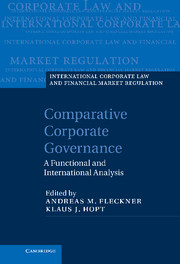2 - Australia
The architecture of corporate governance
from A - Australia and Asia
Published online by Cambridge University Press: 05 July 2013
Summary
Introduction
Although Australia technically has a state-based system of corporate law, the primary legislation, the Corporations Act 2001 (“Corporations Act”), effectively operates as a “federal” rule. This is due to a reference by each state of its powers relating to corporations to the federal government. This broad referral of powers constituted an attempt to unify and harmonize corporate law rules and improve corporate efficiency in Australia.
In spite of this statutory centralization, Australian corporate governance is highly fragmented and occurs “in many rooms.” During the 1990s, the emergence of “corporate governance” as an ubiquitous commercial goal coincided with a deliberate withdrawal from direct regulation by the government. Yet, since that time, Australian corporate law has been the subject of almost continual statutory reform. Not everyone views this dynamic and evolving regulatory picture in a positive light. A former Australian judge has stated, for example, that these reforms have “added substantial . . . complexity” and “created obfuscation” in the area of corporate law. The ongoing focus on good corporate governance in the commercial realm has also contributed to this intricate regulatory picture.
- Type
- Chapter
- Information
- Comparative Corporate GovernanceA Functional and International Analysis, pp. 106 - 155Publisher: Cambridge University PressPrint publication year: 2013
References
- 1
- Cited by

